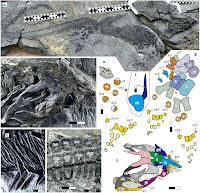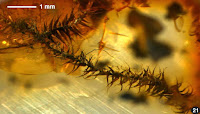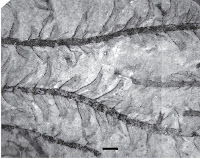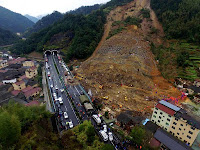Asteroid (441987) 2010 NY65 passed by the Earth at a distance of 4 118 000 km
(10.7 times the average distance between the Earth and the Moon, or 2.75% of the average distance between the Earth and the Sun), at about 10.30 am GMT on Friday 24 June 2016. There was no danger of
the asteroid hitting us, though had it done so it would have presented a
considerable threat. (441987) 2010 NY65
has an estimated equivalent
diameter of 94-300 m (i.e. a spherical body with the same mass would be 94-300 m in diameter), and an towards the upper end of this range
would pass through the atmosphere and directly impact the ground with a
force of about 1110 megatons (about 65 300 times the
explosive energy of
the Hiroshima bomb), causing devastation over a wide area and creating a
crater about 4.6 km across, and resulting in global climatic problems
that
could last for decades or even centuries.
The calculated orbit of (441987) 2010 NY65. JPL Small Body Database.
(441987) 2010 NY65 was discovered on 14 July 2010 by the NEOWISE system on the Wide-field Infrared Survey Explorer
satellite. The designation 2010 NY65 implies that it was the 1649th
asteroid (asteroid Y65) discovered in the first half of July 2010
(period 2010 N), while
the designation 441987 implies that it was 441 987th asteroid ever
discovered (asteroids are not given this longer designation immediately
to avoid naming double or false sightings).
(441987) 2010 NY65 has a 365 day orbital period, with an elliptical orbit tilted at
an angle of 11.6° to the plain of the Solar System which takes in to
0.63 AU from the Sun (63% of the distance at which the Earth orbits the
Sun and inside the orbit of the planet Venus) and out to
1.38 AU (38%
further away from the Sun than the Earth). This means that close
encounters between the asteroid and Earth are fairly common, with the
last thought to have happened in June 2015 and the next predicted
in June 2017. (441987) 2010 NY65 also has frequent close encounters with the
planet Venus, with the last thought to have occurred in June 1999
and
the next predicted for May 2022. Although it does cross the Earth's
orbit and is briefly
further from the Sun on each cycle, (441987) 2010 NY65 spends most of its time
closer to the Sun than we are, and is therefore classified as an Aten
Group Asteroid. As
an asteroid possibly larger than 150 m in diameter that occasionally
comes within 0.05 AU of the Earth, (441987) 2010 NY65 is also classified
as a Potentially Hazardous Asteroid.
See also...
 Asteroid 2016 MA passes the Earth. Asteroid
2016 MA passed by the Earth at a distance of 999 900 km (2.60 times
the average distance between the Earth and the Moon, or 0.66% of
the average distance between the Earth and the Sun), slightly before 4.35 am GMT on Sunday 19 June 2016...
Asteroid 2016 MA passes the Earth. Asteroid
2016 MA passed by the Earth at a distance of 999 900 km (2.60 times
the average distance between the Earth and the Moon, or 0.66% of
the average distance between the Earth and the Sun), slightly before 4.35 am GMT on Sunday 19 June 2016...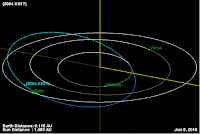 Asteroid 2004 KH17 passes the Earth. Asteroid
2004 KH17 passed by the Earth at a distance of 16 990 000 km
(30.2 times the average distance between the Earth and the Moon, or
11.4% of the average distance between the Earth and the Sun), slightly
before 0.20 am GMT on Thursday 2 June...
Asteroid 2004 KH17 passes the Earth. Asteroid
2004 KH17 passed by the Earth at a distance of 16 990 000 km
(30.2 times the average distance between the Earth and the Moon, or
11.4% of the average distance between the Earth and the Sun), slightly
before 0.20 am GMT on Thursday 2 June... Fireball over Arizona. The American Meteor Society has
received reports of a bright fireball meteor being seen over much of
the southwest United States at about 4.00 am local time on Thursday 2
June 2016 (about 11.00 am GMT).
The fireball was seen across Arizona, Utah, New...
Fireball over Arizona. The American Meteor Society has
received reports of a bright fireball meteor being seen over much of
the southwest United States at about 4.00 am local time on Thursday 2
June 2016 (about 11.00 am GMT).
The fireball was seen across Arizona, Utah, New...
Follow Sciency Thoughts on Facebook.



